Nanopesticides Market Size and Trends
The nanopesticides market is estimated to be valued at USD 0.86 Bn in 2025 and is expected to reach USD 2.05 Bn by 2032, growing at a compound annual growth rate (CAGR) of 13% from 2025 to 2032.
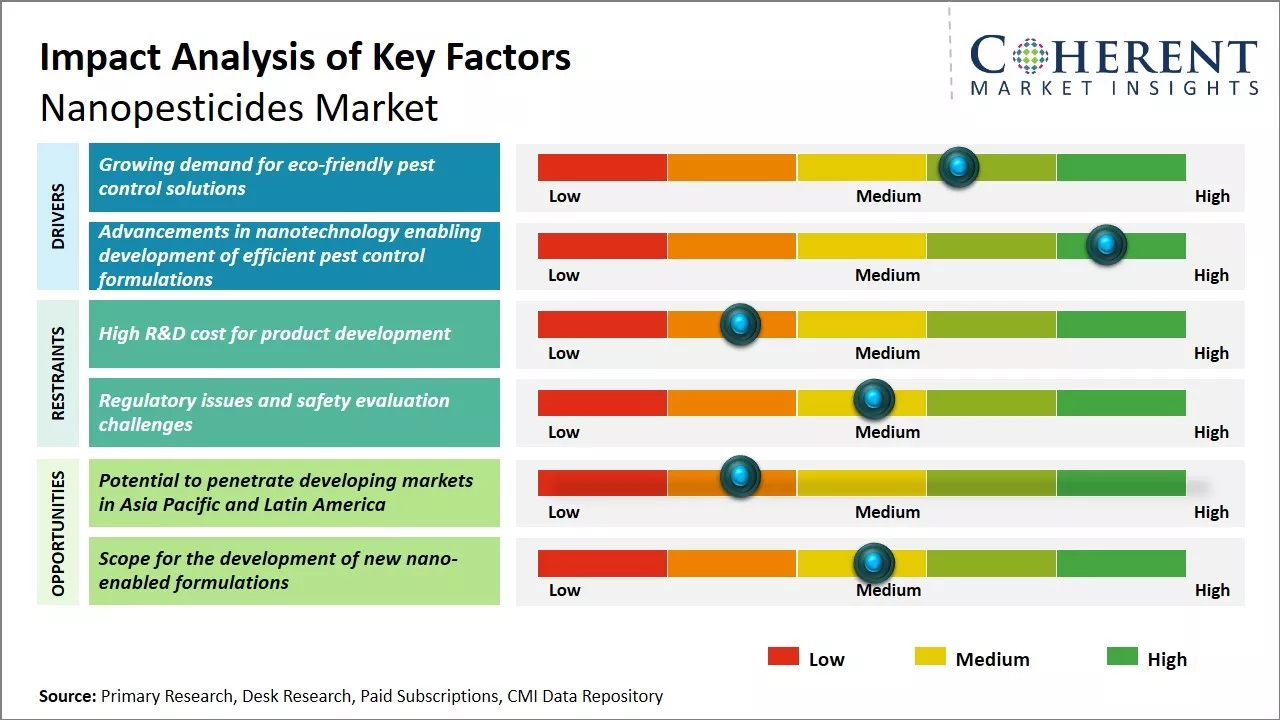
Discover market dynamics shaping the industry: Download Free Sample
Nanopesticides are emerging as an effective alternative to conventional pesticides. The growing need to increase agricultural productivity with reduced chemical usage is expected to drive demand. Conventional pesticides are facing increasing restrictions due to environmental and health concerns. Nanopesticides can overcome these limitations as they require lower volumes, have longer shelf life and more effective pest control at lower concentrations. They also help minimize invasive species and resistance development in pests. With sustainable solutions gaining prominence, the nanopesticides market is well-positioned for significant growth in the coming years.
Growing demand for eco-friendly pest control solutions
The global agricultural industry has been facing increasing pressure in recent years to reduce the use of conventional pesticides and switch to more environmentally sustainable practices. The heavy reliance on synthetic chemical pesticides has led to a variety of environmental and health concerns over time. Issues like pest resistance, pesticide residue in food and water sources, negative impacts on biodiversity, and health hazards for farmers have contributed to growing demand for natural and eco-friendly alternatives. Nanopesticides are emerging as a promising substitute as they can be designed for targeted delivery and controlled release of active ingredients, allowing for reduced dosage and frequency of application. This leads to lower agricultural input costs as well as minimizes the risks of pesticide runoff and pollution. With environmental sustainability gaining priority among farmers, governments, and consumers alike, the demand for such innovative 'green' solutions is expected to surge.
Market Concentration and Competitive Landscape
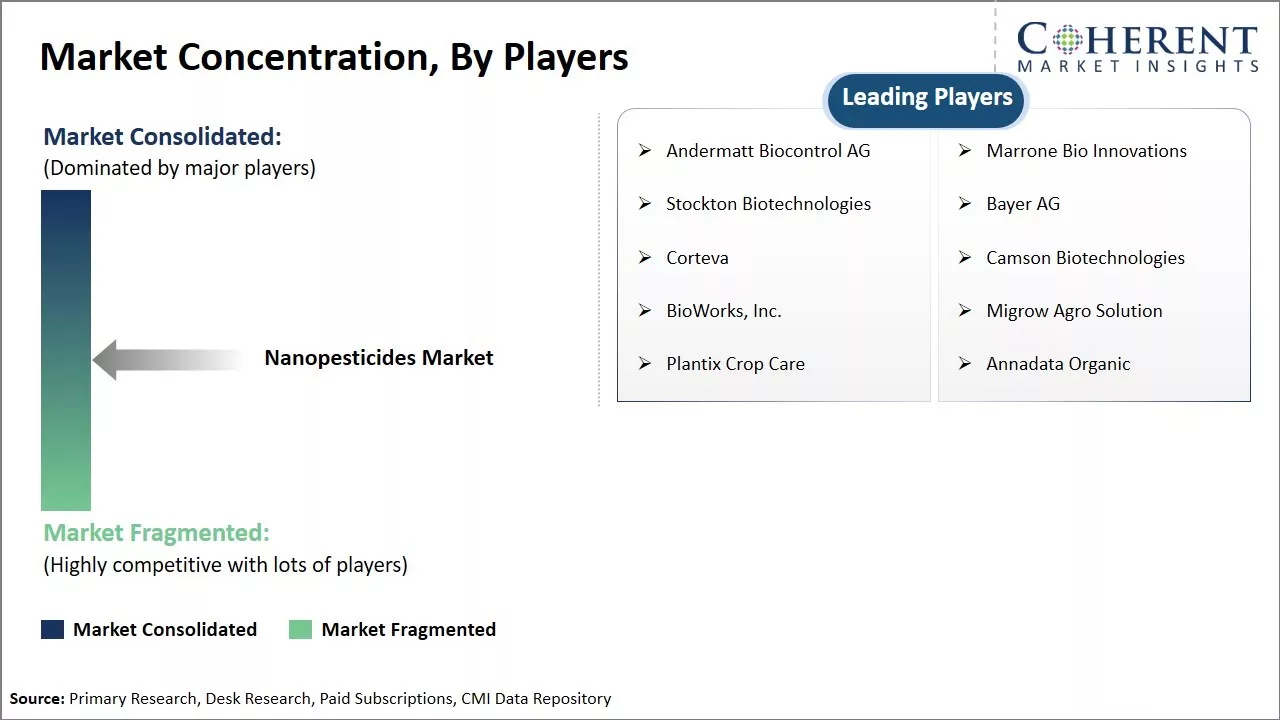
Get actionable strategies to beat competition: Download Free Sample
Advancements in nanotechnology enabling development of efficient pest control formulationsOver the past decade or so, intensive research efforts from scientists and companies have helped unlock the potential of applying nanotechnology concepts for developing improved pesticides. Manufacturers have been able to leverage nano-engineering methods to encapsulate active ingredients within nanoparticles of varying sizes, surface properties, and structures. This allows for incorporating desirable characteristics like water-dispersion, photo-/thermo-responsiveness into the new formulations. Some key advancements include targeted foliar delivery using dendrimers, controlled-release mechanisms based on biodegradable polymers, and stimuli-responsive carriers for on-demand pesticide activation. Such customized fabrication at the nano-scale is making it possible to enhance the bioavailability, selectivity and effectiveness of active constituents. It is also laying the foundation for more specialized product categories like nano-fungicides, nano-insecticides, and nano-herbicides. The continuous progress in R&D as well as large private investments have boosted the potential for the commercialization of next-gen nanopesticide products with superior performance over conventional solutions. This is expected to be a major factor driving greater adoption globally.
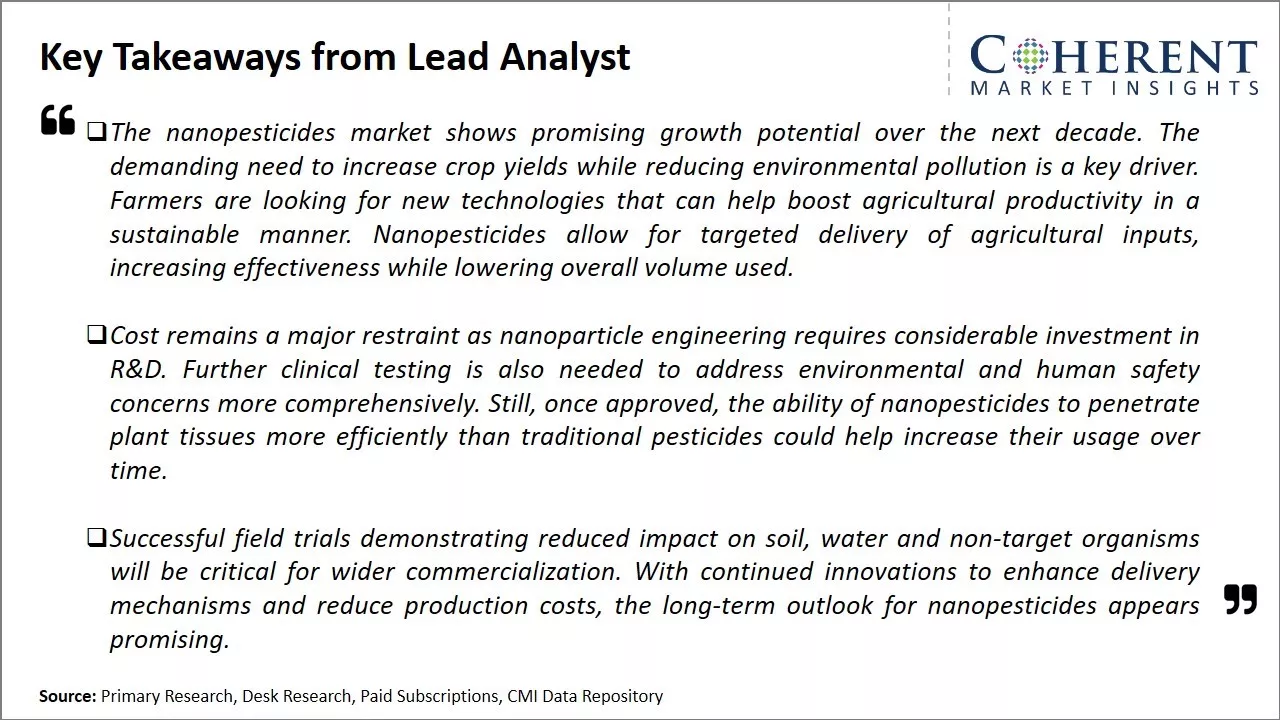
To learn more about this report, Download Free Sample
Challenge: High R&D cost for product developmentDeveloping new nanopesticides formulations requires extensive research to ensure the safety of nano-enabled agrochemicals for both humans and the environment. Nano-enabled formulations aim to improve the delivery and effectiveness of existing agrochemical actives. However, testing the impact of nano-carriers and assessing their interactions with active ingredients involves complex experimental procedures and analysis. This significantly increases the costs associated with product development. Conducting toxicity tests in line with regulatory standards further raises R&D expenses. Nanotoxicity assessment involves long-term in vivo and in vitro studies to understand acute and chronic effects of nanoparticles. Testing for oral, dermal, and inhalation exposure routes has to be performed as nanoparticles can be absorbed via multiple pathways. Evaluating immuno-toxicity and genotoxicity of novel nanopesticide formulations using advanced diagnostic techniques like polymerase chain reaction (PCR) and enzyme-linked immunosorbent assay (ELISA) increases financial investment. Regulatory dossiers compiling safety and efficacy data need to be prepared adhering to guidelines of authorities like the US Environmental Protection Agency (EPA). This regulatory burden on developing bio-safe and eco-friendly nanotechnology-driven agrochemicals increases costs.
Opportunity: Potential to penetrate developing markets in Asia Pacific and Latin America
Both regions have seen a significant rise in agricultural output and farming activities over the past decade to meet the rising food demands of their vast populations. However, smallholder farmers who contribute significantly to the agricultural production in these regions often struggle with issues like pest attacks on crops, lack of access to advanced pest management solutions, and financial constraints. Nanopesticides could help address some of these challenges for small and marginal farmers in Asia Pacific and Latin America. Due to their targeted nature, nanopesticides require lower volumes and frequencies of application compared to conventional pesticides, thereby reducing input costs for farmers. Their precise pest control ability also minimizes collateral damage to crops, environment and non-target organisms. This makes nanopesticides an economically viable and environment-friendly solution for smallholder farmers.
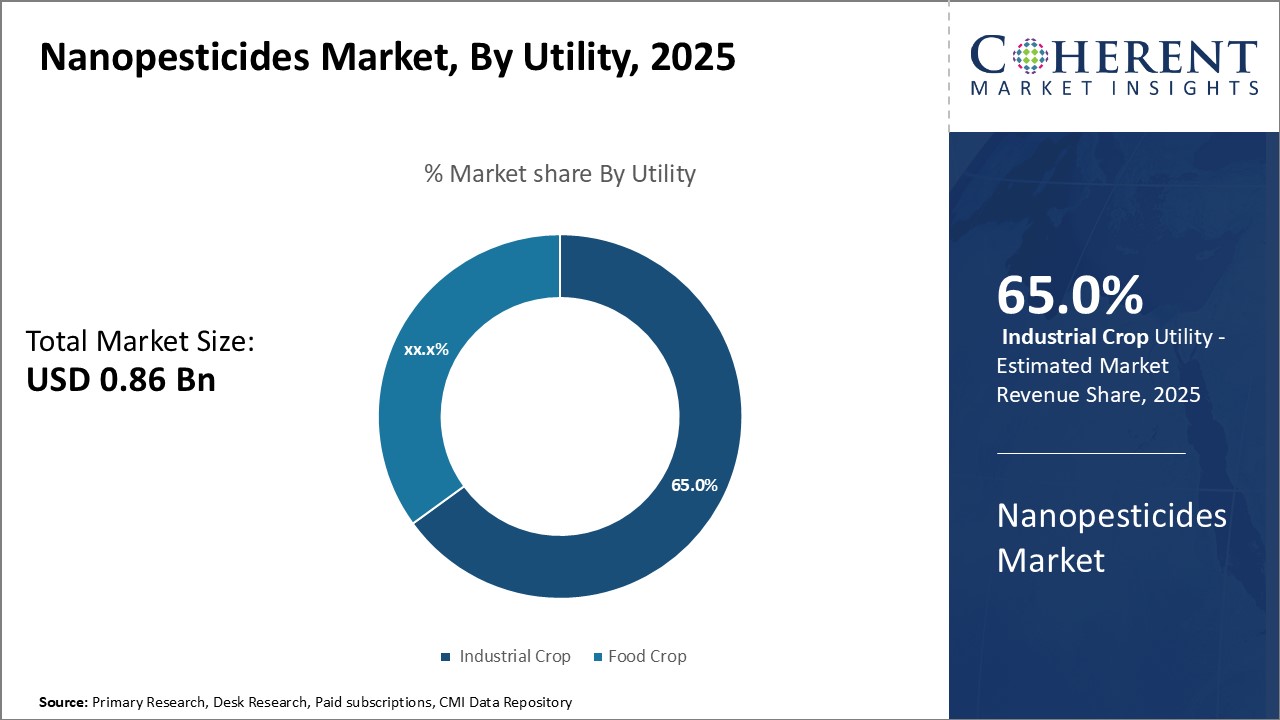
Discover high revenue pocket segments and roadmap to it: Download Free Sample
Insights by Utility: Rising Demand for High-yield Crops Drive Growth in Industrial CropsThe industrial crop segment is expected to contribute 65.0% share of the nanopesticides market in 2025, by utility due to the rising global demand for high-yield crops. Industrial crops such as soybean, corn, sugarcane, and cotton are in high demand worldwide to meet the needs of food processing industries as well as textile industries. Nanopesticides provide precision application and effective pest control methods that allow farmers to maximize crop yields from industrial crops. The cost of production is a major factor influencing profitability in industrial crop farming. Nanopesticides enable selective targeting of pests without harming beneficial insects, reducing the amount of pesticides needed and lowering input costs for farmers. Their controlled release properties also ensure pesticides are delivered only where needed, minimizing wastage. This boosts crop protection efficiency and productivity per acre. Climate change is bringing new climate patterns that expand the habitat of crop pests. Industrial farms need innovative solutions to counter unpredictable pest infestations that threaten crop supplies. Nanopesticides have shown effectiveness against a wide range of emerging pests while posing minimal risks to the environment. Their ability to prevent total crop failure even in difficult conditions makes them invaluable for maintaining industrial crop yields.
Insights by Type: Growth in Global Population Drives the Demand for Nanoinsecticides
Within the type segment, nanoinsecticides is expected to contribute 36.1% of the market share in 2025, owing to the rising global population and corresponding demand for food. Insects are among the most destructive agricultural pests, capable of decimating entire harvests if left uncontrolled. As the world population rises exponentially, there is immense pressure on farmers to boost insect-resistant crop production to ensure global food security. Nanoinsecticides target and eliminate key insect pests more precisely than conventional pesticides. Their nanoparticle properties facilitate the penetration of insect cuticles and systematic distribution within plant tissues, achieving complete pest control with minimal active ingredients. This increases crop protection efficiency while reducing insecticide usage—an important sustainability factor with growing world resource constraints. Urbanization is also concentrating global population in cities, diminishing available arable land. To maximize yields from limited land areas, farmers require tools like nanoinsecticides that help increase crop cultivation intensity through reliable, multi-season pest suppression. Their selective activity profiles protect pollinators and natural enemies too, keeping agro ecosystems balanced for sustained productivity gains. These advantages make nanoinsecticides especially valued for satisfying the global demand for staple grains and pulses in current population scenarios.
Insights by End-user: Increased Non-agricultural Applications Drive Growth in Non-agricultural End Users
The non-agricultural segment is expected to hold 65.9% of the market share in 2025, by end-user owing to rising applications of nanopesticides beyond traditional farming. While agriculture remains their core use, nanoparticle formulations are also increasingly used in forestry, ornamental horticulture, public recreation areas, and structural pest control management. In forestry, nanopesticides help tackle new pests and diseases threatening commercial woodlands and biodiversity. Their controlled environmental behavior prevents widespread contamination issues. In turf and ornamental plant management, nanopesticides offer a non-toxic alternative to conventional pesticides for maintaining public green spaces. Their self-disinfecting properties also provide effective protection of infrastructure from structural pests like termites. Nanopesticides can be incorporated into building materials during construction, forming a long-term pest-proof barrier. This is driving their adoption in managing pests in public structures, hotels, offices and other facilities. As urban lifestyles expand non-agricultural land usage, the need for sustainable pest control in these areas grows. Nanopesticides are well-suited to satisfy this rising demand through tailored, eco-friendly solutions. This growing applicability outside conventional farming is a key factor propelling the non-agricultural end-user segment.
Regional Insights
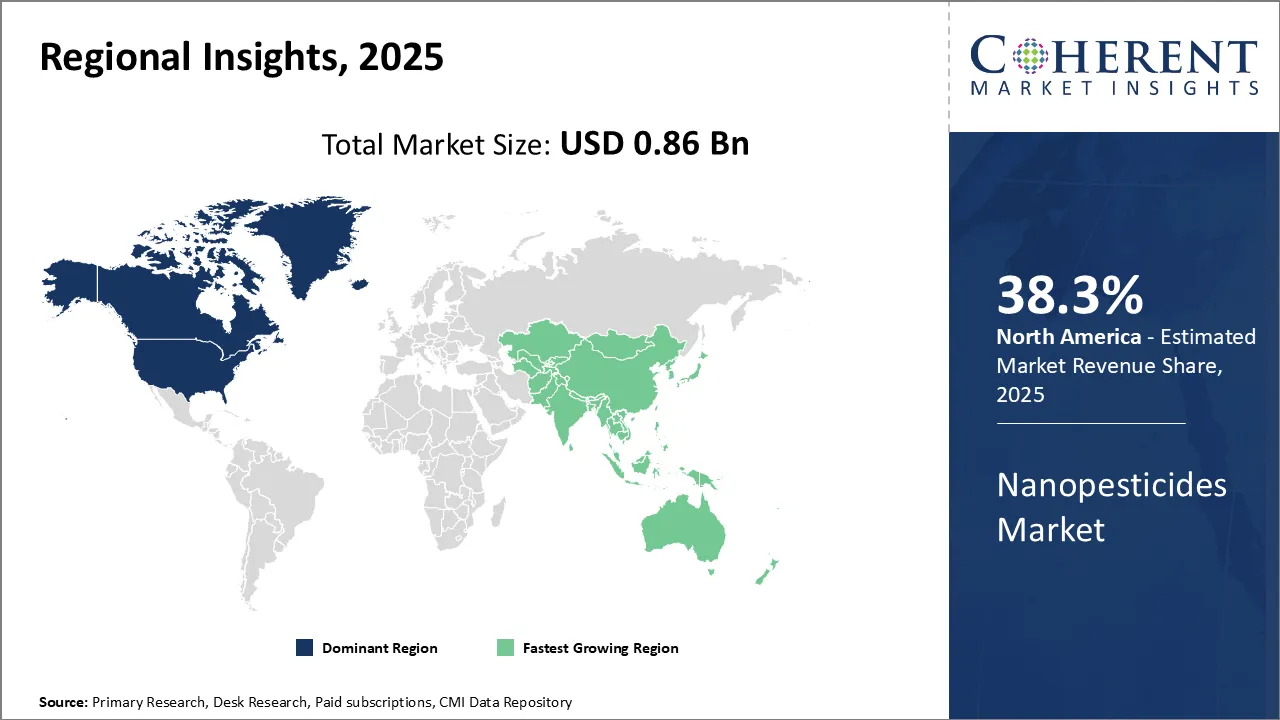
Need a Different Region or Segment? Download Free Sample
North America has established itself as the dominant region in the global nanopesticides market. This region is expected to account for 38.3% of the market share in 2025. The developed agriculture industry and high adoption of advanced technologies in the U.S. and Canada are major drivers of the nanopesticide demand. Leading agrochemical producers have their headquarters located in the region and invest heavily in R&D for new nanopesticides formulations. Strict environmental regulations regarding conventional pesticides also encourage farmers to switch to nano-enabled solutions for their efficacy even at low concentrations. Trade relationships with Latin American countries ensure a steady flow of key agrochemicals and result in competitive prices for farmers.
Asia Pacific has emerged as the fastest growing regional market for nanopesticides in recent years. Rapid expansion of the agriculture sector and rising population levels have increased the need for high crop yields. Countries like India and China represent over a third of the global population and are heavily investing in agricultural infrastructure and technologies. Local agrochemical manufacturers are partnering with international players and universities to develop tailored nano-enabled products. Support from government initiatives aimed at modernizing farming practices and minimizing crop losses is further boosting adoption. Export potential to rest of Asia Pacific and Europe also makes the region an attractive production base. While regulatory guidelines still need more clarity, the appetite for boosting farm output should continue accelerating the APAC market at an impressive pace.
Market Report Scope
Nanopesticides Market Report Coverage
| Report Coverage | Details | ||
|---|---|---|---|
| Base Year: | 2024 | Market Size in 2025: | USD 0.86 Bn |
| Historical Data for: | 2020 To 2024 | Forecast Period: | 2025 To 2032 |
| Forecast Period 2025 to 2032 CAGR: | 13.2% | 2032 Value Projection: | USD 2.05 Bn |
| Geographies covered: |
|
||
| Segments covered: |
|
||
| Companies covered: |
Andermatt Biocontrol AG, Marrone Bio Innovations, Stockton Biotechnologies, Bayer AG, Corteva, Camson Biotechnologies, BioWorks, Inc., Migrow Agro Solution, Plantix Crop Care, and Annadata Organic |
||
| Growth Drivers: |
|
||
| Restraints & Challenges: |
|
||
Uncover macros and micros vetted on 75+ parameters: Get instant access to report
Market Segmentation
- Utility Insights (Revenue, USD Bn, 2020 - 2032)
- Food Crop
- Industrial Crop
- Type Insights (Revenue, USD Bn, 2020 - 2032)
- Nanoinsecticides
- Nanoherbicides
- Nanofungicides
- Others
- End-user Insights (Revenue, USD Bn, 2020 - 2032)
- Agriculture
- Non-agriculture
- Target Organism Insights (Revenue, USD Bn, 2020 - 2032)
- Algicides
- Avicides
- Bactericides
- Fungicides
- Herbicides
- Insecticides
- Others
- Regional Insights (Revenue, USD Bn, 2020 - 2032)
- North America
- U.S.
- Canada
- Latin America
- Brazil
- Argentina
- Mexico
- Rest of Latin America
- Europe
- Germany
- U.K.
- Spain
- France
- Italy
- Russia
- Rest of Europe
- Asia Pacific
- China
- India
- Japan
- Australia
- South Korea
- ASEAN
- Rest of Asia Pacific
- Middle East & Africa
- GCC Countries
- Israel
- Rest of Middle East & Africa
- North America
- Key Players Insights
- Andermatt Biocontrol AG
- Marrone Bio Innovations
- Stockton Biotechnologies
- Bayer AG
- Corteva
- Camson Biotechnologies
- BioWorks, Inc.
- Migrow Agro Solution
- Plantix Crop Care
- Annadata Organic
Share
Share
About Author
Yash Doshi is a Senior Management Consultant. He has 12+ years of experience in conducting research and handling consulting projects across verticals in APAC, EMEA, and the Americas.
He brings strong acumen in helping chemical companies navigate complex challenges and identify growth opportunities. He has deep expertise across the chemicals value chain, including commodity, specialty and fine chemicals, plastics and polymers, and petrochemicals. Yash is a sought-after speaker at industry conferences and contributes to various publications on topics related commodity, specialty and fine chemicals, plastics and polymers, and petrochemicals.
Missing comfort of reading report in your local language? Find your preferred language :
Transform your Strategy with Exclusive Trending Reports :
Frequently Asked Questions
EXISTING CLIENTELE
Joining thousands of companies around the world committed to making the Excellent Business Solutions.
View All Our Clients
